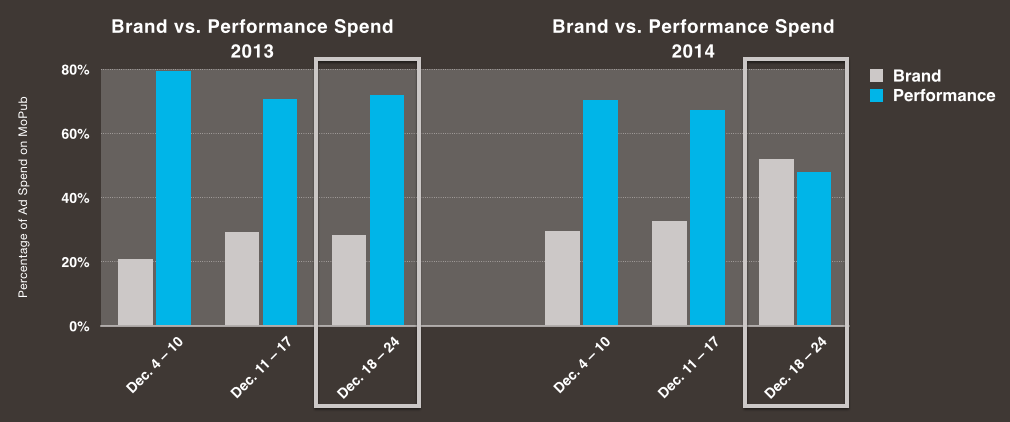ExchangeWire Weekly Research Round-Up
by on 26th Mar 2015 in News


ExchangeWire Research’s weekly round up brings you up-to-date research findings from around the world, with additional insight provided by Rebecca Muir, ExchangeWire, head of research and analysis (pictured). In this week’s edition: growth in the mobile advertising marketplace as reported by MoPub; eMarketer finds that smart TV adoption in the UK has got off to a slow start and Rocket Fuel’s report creative performance trends in banner adverts.
MoPub records increase in mobile brand spend
 MoPub’s Mobile Advertising Marketplace Report shows a substantial increase in brand spend on mobile advertising during December 2014, when compared to the previous year. In 2013, brand advertising made up around 20% of spend through MoPub, in 2014 ad spend on brand campaigns had jumped to over 50%, in other words, advertisers were investing more in brand campaigns than performance campaigns.
MoPub’s Mobile Advertising Marketplace Report shows a substantial increase in brand spend on mobile advertising during December 2014, when compared to the previous year. In 2013, brand advertising made up around 20% of spend through MoPub, in 2014 ad spend on brand campaigns had jumped to over 50%, in other words, advertisers were investing more in brand campaigns than performance campaigns.
The value of mobile advertising also appears to have increased, with MoPub reporting a 15% year-on-year increase in CPM. This is likely to be a result of improved tracking capabilities allowing brands to identify the contribution of in-app advertising impressions to their consumer’s path-to-purchase.
The industry has also seen more brands extending their mobile ecommerce functionality over the past year, which has made it easier for consumers to interact with brands on a mobile device and will no doubt have helped boost the in-app mobile advertising economy.
In addition, the report highlights that rich media and video ad formats are helping publishers monetise their inventory at higher rates (+33%) when compared to traditional ad formats.
The report provides market data from real-time auctions for mobile ad impressions aggregated from mobile applications, advertisers and demand side platforms (DSPs) on MoPub marketplace. The data is representative of over 170 billion monthly ad requests, more than one billion unique devices and 140+ DSPs. Read the full report here.
Smart TV adoption takes a stuttering start
 In recent months, TV advertising has received a lot of attention from the programmatic community as the industry takes its first, tentative steps towards the programmatic trading of TV advertising.
In recent months, TV advertising has received a lot of attention from the programmatic community as the industry takes its first, tentative steps towards the programmatic trading of TV advertising.
However, reality may not live up to the hype just yet, as eMarketer echoes YouGov findings that there has only been a 4% increase (from 25% to 29%) in the number of UK consumers aged 16 and over who have access to a smart TV at home.
This begs the question as to whether consumers see enough value to justify the additional investment required to move from a traditional to a smart TV. With consumers already more than comfortable using mobile devices to browse video content online, and screen mirroring functionality readily available, it remains to be seen whether smart TVs will become mainstream in the UK and propel the programmatic TV advertising model.
Optimising creativity through data
 ExchangeWire firmly believes that programmatic increases the options for creativity in online advertising. However, for many there is a perception that the data-driven world of programmatic is lacking in creativity, especially when compared to other forms of visual advertising.
ExchangeWire firmly believes that programmatic increases the options for creativity in online advertising. However, for many there is a perception that the data-driven world of programmatic is lacking in creativity, especially when compared to other forms of visual advertising.
That being said, Rocket Fuel has released a report which shows performance trends associated with various aspects of creative variations which for advertisers offers an opportunity to embrace creative options to increase performance. The report delves into vertical specific findings as well as offering overall findings.
Key findings include:
• Red is the best performing background colour (31%), while cream is the worst (-23%)
• 6-9 seconds of animation provides a performance boost of +138%, whereas, more than 13 seconds of animation has a negative effect (-68%)
• Logo placement matters, the lower left corner of an ad proved to be the best area to place the logo (81% performance boost) but placing the logo in the bottom right part of the creative has the opposite effect (-24%)
Rocket Fuel’s full report can be downloaded here.
AdvertiserBrandingCross-ChannelDataDigital MarketingDisplayEMEAExchangeExchangeWire ResearchMedia SpendMobilePerformanceTargetingTVVideo








Follow ExchangeWire